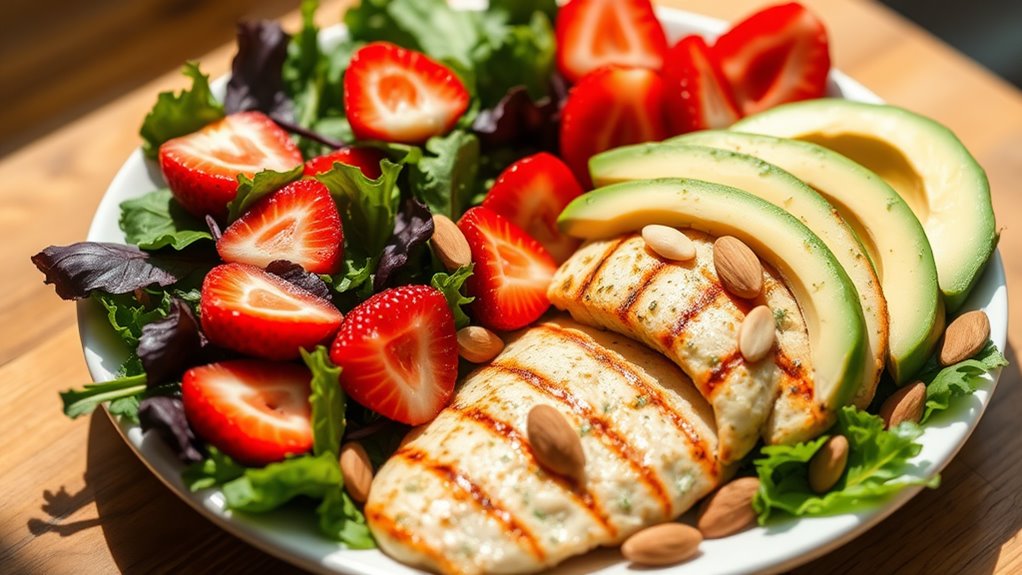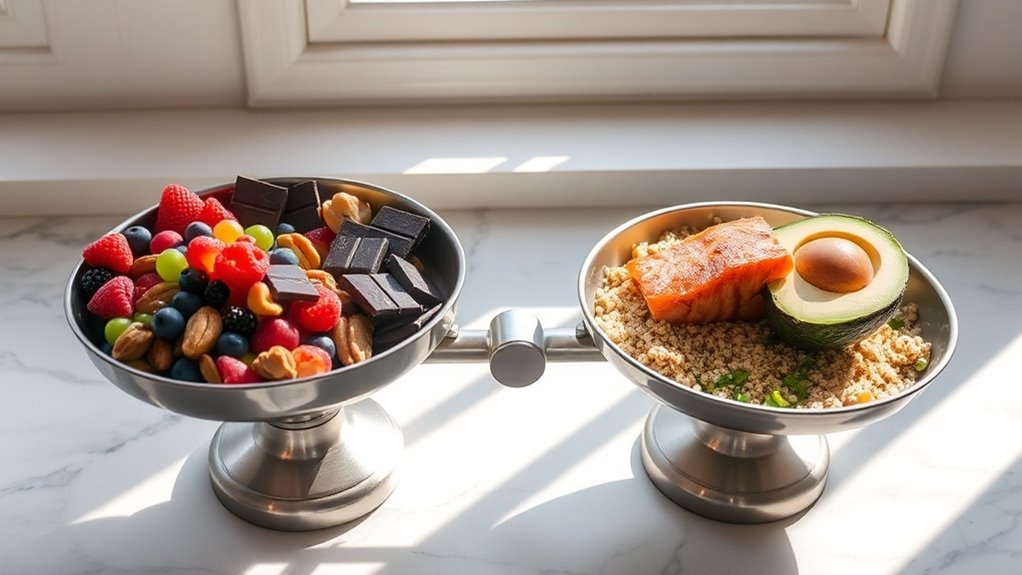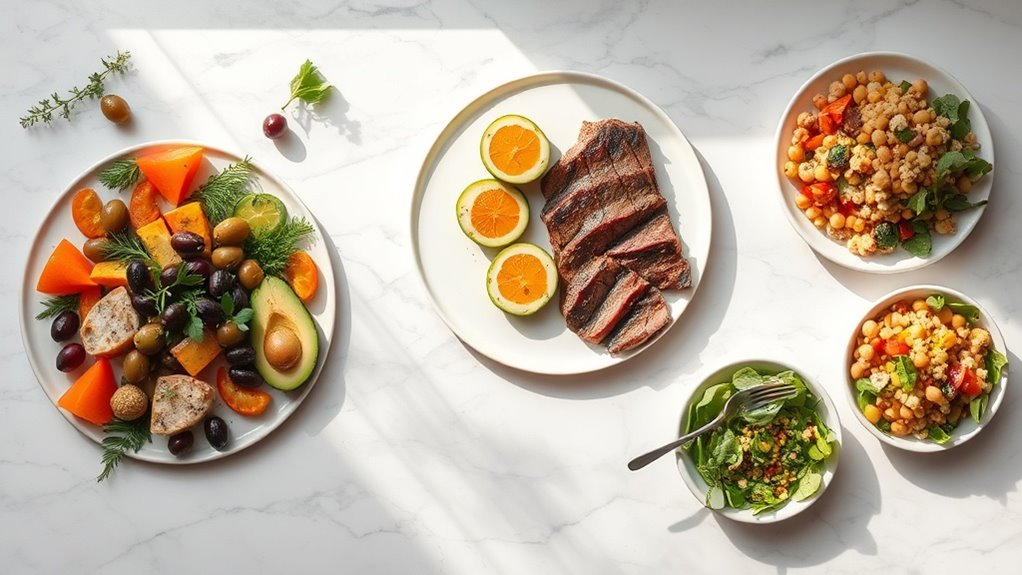What Nutritionists Eat When They Want to Slim Down
While fad diets promise quick fixes, you’re choosing nutritionists’ evidence-based path with high-protein meals for sustainable slimming. These pros prioritize options like Greek yogurt or veggie omelets to boost satiety and metabolism, keeping portions in check. Picture how these tweaks could reshape your routine—stay tuned for practical strategies that keep you energized and on track.
High-Protein Breakfast Choices
Starting your day with a high-protein breakfast can boost your weight loss efforts by enhancing satiety and metabolism.
As a key part of nutritionist tips for weight loss, you’ll want to choose options like Greek yogurt with nuts or eggs with veggies, which provide at least 20-30 grams of protein to curb hunger.
Studies show these choices stabilize blood sugar, reducing snack cravings later. You can prepare a quick omelet or smoothie with protein powder; it’s simple and effective. Additionally, consuming coffee can enhance workout performance and further support your weight loss journey.
Follow these tips by tracking your intake—aim for lean sources to build sustainable habits and accelerate fat loss.
Nutrient-Rich Lunch Options
You’ll build a balanced lunch around salad-based options like mixed greens with colorful veggies, which provide essential vitamins and help control portions for effective weight loss.
Add protein-rich choices such as lentils or tuna to sustain your energy and curb hunger pangs.
Veggie-filled meals, like stir-fries with broccoli and peppers, deliver fiber that aids digestion and keeps you on track with your slimming goals. Including lean proteins in your meals boosts metabolism and supports muscle maintenance.
Salad-Based Lunches
As you build a balanced diet for slimming down, salad-based lunches deliver nutrient-rich options that keep you energized and satisfied.
They’re packed with fiber and vitamins from fresh produce, helping you manage hunger and support steady energy levels, as backed by dietary research.
To optimize your salads for weight loss:
-
Prioritize variety: Select diverse greens and veggies like spinach, arugula, and tomatoes for a broad spectrum of nutrients that enhance satiety and digestion.
-
Balance with fibers: Add beans or whole grains for complex carbs that stabilize blood sugar and extend fullness without spiking calories.
-
Incorporate healthy fats****: Use avocado or olives sparingly to improve nutrient absorption and curb cravings, promoting a feeling of fullness.
-
Focus on hydration: Include cucumber and herbs to boost water content, aiding metabolism and preventing overeating for effective calorie control.
Protein-Rich Options
Protein-rich options form a cornerstone of nutrient-rich lunches, helping you build and maintain muscle while curbing hunger for effective weight loss.
You can opt for grilled chicken or turkey, which provide lean protein to boost metabolism, as studies show it increases satiety.
Try eggs or Greek yogurt for a quick, portable boost; they’re packed with amino acids that support fat loss.
For plant-based choices, incorporate lentils or chickpeas—they’re versatile and help stabilize blood sugar.
Always pair with whole grains for balance, ensuring you’re fueled without excess calories.
Aim for 20-30 grams per meal to stay on track.
Veggie-Filled Meals
Vegetables anchor nutrient-rich lunches, delivering vitamins, minerals, and fiber that promote weight loss and overall health.
You boost metabolism and control hunger by making veggies the star of your plate, as studies show they enhance satiety without excess calories.
-
Prioritize leafy greens****: Spinach or kale provide folate and iron, aiding energy and reducing bloating for easier slimming.
-
Incorporate colorful varieties****: Bell peppers and carrots offer antioxidants that combat inflammation, supporting fat loss.
-
Balance with portion control****: Fill half your plate with veggies to naturally cut calories while maintaining nutrition.
-
Experiment with preparation: Grill or steam broccoli to preserve nutrients and flavors, making meals enjoyable and sustainable.
Healthy Snack Ideas
When you’re aiming to slim down, smart snack choices can curb cravings without derailing your diet. Opt for Greek yogurt topped with fresh berries; research shows protein-rich snacks like this enhance satiety and support weight loss. Grab a handful of almonds for healthy fats and fiber, which stabilize blood sugar and reduce overeating. Crunch on carrot sticks with hummus for vitamins and low-calorie satisfaction. Try an apple with a touch of nut butter for natural sweetness and sustained energy. Always measure portions to keep calories in check, making these options practical for busy days. Staying hydrated is also important, as thirst can mimic hunger, which can impact your snacking choices.
Balanced Dinner Recipes
As you plan your evening meal, incorporating balanced dinner recipes helps maintain weight loss by combining lean proteins, whole grains, and veggies for optimal nutrition.
These meals promote satiety and steady energy, reducing overeating risks.
To craft effective recipes:
-
Prioritize lean proteins like grilled salmon, which studies show enhance muscle retention and increase calorie burn.
-
Integrate whole grains such as quinoa, providing fiber that aids digestion and controls blood sugar.
-
Emphasize vegetables like broccoli, delivering essential nutrients while adding volume without excess calories.
-
Balance portions to align with your caloric needs, ensuring meals support long-term metabolic health.
Additionally, including quinoa’s complete protein in your meals can further enhance satiety and support your weight loss goals.
This approach keeps your dinners nutritious and sustainable.
Hydration and Beverage Picks
Staying hydrated plays a key role in your slimming journey, as it boosts metabolism and curbs unnecessary snacking. You choose the right water options by opting for plain or infused varieties without added sugars, which studies show help maintain energy levels. When picking healthy beverages, go for unsweetened teas or low-calorie options like vegetable juices to support your weight loss goals. Additionally, proper hydration can enhance workout performance, allowing for more calorie burn.
Water Choices
Hydration is key to supporting your metabolism and curbing hunger during weight loss, so focus on smart beverage choices to maximize results.
You’ll boost your efforts by prioritizing water varieties that enhance purity and appeal, helping you stay consistent without empty calories.
-
Opt for filtered water****: It removes contaminants, reducing exposure to potential toxins that could hinder your body’s efficiency.
-
Select spring or mineral water*: These provide natural electrolytes, supporting electrolyte balance for better *hydration and energy.
-
Infuse with zero-calorie add-ins****: Like cucumber or lemon, to make water more enjoyable and encourage higher intake.
-
Monitor your intake daily: Track consumption to meet personalized needs, ensuring optimal hydration for metabolism.
Healthy Beverages
Beyond water choices, you can enhance your hydration by exploring other smart beverage options that support weight loss and overall health.
Green tea, packed with catechins, boosts metabolism according to studies, helping burn fat more efficiently.
Black coffee delivers antioxidants and curbs appetite, but limit intake to two cups daily to prevent jitters.
Herbal teas like chamomile soothe digestion and reduce bloating without calories.
Infused water with cucumber or lemon adds nutrients and flavor, keeping you refreshed.
Opt for low-sugar vegetable juices, such as carrot, for vitamins that promote fullness and sustained energy, aiding your slimming efforts.
Meal Prep Strategies
When you plan your meals ahead, you’ll make smarter choices that support weight loss by controlling portions and prioritizing nutrient-dense foods.
Studies show this strategy boosts adherence and cuts impulsive snacking, making it easier to sustain a calorie deficit while staying nourished. Meal planning also reduces stress associated with meal decisions, allowing for a more focused approach to healthy eating.
Here’s how to implement effective meal prep strategies:
-
Batch cook staples: Prepare large quantities of veggies, proteins, and grains in advance to save time and ensure quick access to balanced meals.
-
Balance your plate: Include lean proteins, whole grains, healthy fats, and vegetables in each prep to optimize nutrients and satiety.
-
Control portions: Use measuring cups or portioned containers to accurately manage calories and prevent overeating.
-
Add variety: Rotate ingredients and flavors weekly to keep meals exciting, reducing the risk of dietary boredom and promoting long-term success.





